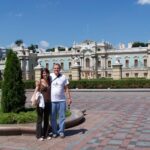
A week ago, the Vienna Philharmonic’s three-night stop at Carnegie Hall, which began Friday, was remarkable mostly for signifying a major step in the slow return of international orchestras to New York. Then Russia invaded Ukraine.
The Viennese had been set to be conducted by Valery Gergiev, a frequent magnet for protests at Carnegie Hall over his close ties with President Vladimir V. Putin of Russia. Both Carnegie and the Philharmonic had previously been outspoken about separating Gergiev’s politics and his artistry, even though his artistry is inseparable from the government.
Come Thursday, when phrases like “the whole world has changed” started to surface, Gergiev’s relationship with Putin became “untenable,” as Clive Gillinson, Carnegie’s executive and artistic director, told The New York Times. Gergiev was dropped from Philharmonic concerts; so was Denis Matsuev, the planned soloist in Rachmaninoff’s Second Piano Concerto, who had publicly endorsed Putin’s policies in the past.
Gergiev has not commented on the invasion, even as many classical musicians who didn’t need to have. (Until Saturday, the star soprano Anna Netrebko, another Putin supporter, was also silent before she posted a face-saving statement to Instagram saying she was “opposed to this war,” with a defiant coda that “forcing artists, or any public figure, to voice their political opinions in public and to denounce their homeland is not right.”) If Gergiev doesn’t speak out, he faces more cancellations: from the Teatro alla Scala in Milan; the Munich Philharmonic, where he is the chief conductor; and the Rotterdam Philharmonic Orchestra, which had been planning a festival in his honor.
But back to the Vienna Philharmonic.
With the news of Gergiev’s departure came the announcement that Yannick Nézet-Séguin, neither a stranger to the Philharmonic nor much of a regular, would step in — bringing his total number of appearances at Carnegie this season to more than a dozen. He had just led the Philadelphia Orchestra, of which he is the music director, there on Monday, and was preparing to open a new production of Verdi’s “Don Carlos” on Feb. 28 at the Metropolitan Opera, where he is also the music director. Suddenly, he was conducting three Vienna concerts, with three different programs, in between. (As if that weren’t enough, he opens a revival of “Tosca” at the Met on Wednesday; when vacation comes, it will be well earned.)
Then a pianist needed to be found. Seong-Jin Cho, who lives in Berlin, agreed around midnight his time on Friday, and was on a plane to New York within about seven hours. He hadn’t played the Rachmaninoff concerto since 2019, and had never worked with the Philharmonic; for more pressure, this was going to be his orchestral debut at Carnegie.
Because Nézet-Séguin was spending much of Friday in the final dress rehearsal for “Don Carlos,” the Vienna concert wasn’t rehearsed until 6 p.m. — and even then, for only 75 minutes ahead of the start time at 8. Never mind that the program, of the concerto and Rachmaninoff’s Second Symphony, contained over 90 minutes of music.
Yet someone living under a rock could have walked into this concert, knowing none of its context, and been perfectly happy. Indeed, Friday’s performance was probably better than it would have been under the baton of Gergiev — who, politics aside, is too often an unreliable conductor — and with Matsuev, who tends to barrel insensitively through war horses like the Rachmaninoff.
Nézet-Séguin didn’t merely keep time or hold the Philharmonic together; he led them with passion and decisive interpretation. And Cho didn’t simply get through the concerto; he played it from memory, with moments of sublime delicacy. This was expert music-making, notable for happening at all and miraculous in its execution.
Understand Russia’s Attack on Ukraine
What is at the root of this invasion? Russia considers Ukraine within its natural sphere of influence, and it has grown unnerved at Ukraine’s closeness with the West and the prospect that the country might join NATO or the European Union. While Ukraine is part of neither, it receives financial and military aid from the United States and Europe.
There certainly have been finer accounts of Rachmaninoff’s Second Piano Concerto, but few under Friday’s circumstances. So you could forgive Cho’s touch, a little light for the work’s uphill battle of balance with the massive orchestration. His sound, though, was intriguingly less an outpouring of emotion or virtuosity, and more a flowing series of seemingly spontaneous thoughts, with a gently gliding accompaniment under brightly articulated melodies in the right hand. Nézet-Séguin and the Philharmonic similarly approached the score phrase by phrase, each set off with clear contours of volume and expression. In the truest sign that this evening was more skillful than haphazard, the finale’s fugue, a flash of Bach, was satisfyingly precise — Cho and the violins aligned even in their fleet delivery.
As the audience applauded afterward, Nézet-Séguin and Cho gave each other a long hug. And when Cho returned to the bench for an encore, a wistful and masterly voiced “October: Autumn Song” from Tchaikovsky’s “The Seasons,” the conductor sat in the back row of the strings, listening with an attentive yet serene look on his face.
But the concert wasn’t over. Nézet-Séguin still had the Second Symphony, in this reading constantly elevated and passionate on the level of Wagner. Here was the Philharmonic in its signature lushness, yet later lithe in the scherzo-esque second movement. The expressive Adagio, after opening with a tender clarinet solo, was not merely emotional but tense and teeming as it built toward a radiant climax and release. And the finale’s final bars were so rousing, the audience began to cheer before Nézet-Séguin had even lowered his baton.
Standing ovations are something of a default response in New York. But you can also tell when they’re more immediate, more spirited — more sincere. That was the case on Friday, and it didn’t feel at all like an overreaction.
Vienna Philharmonic
Through Sunday at Carnegie Hall, Manhattan; carnegiehall.org.




